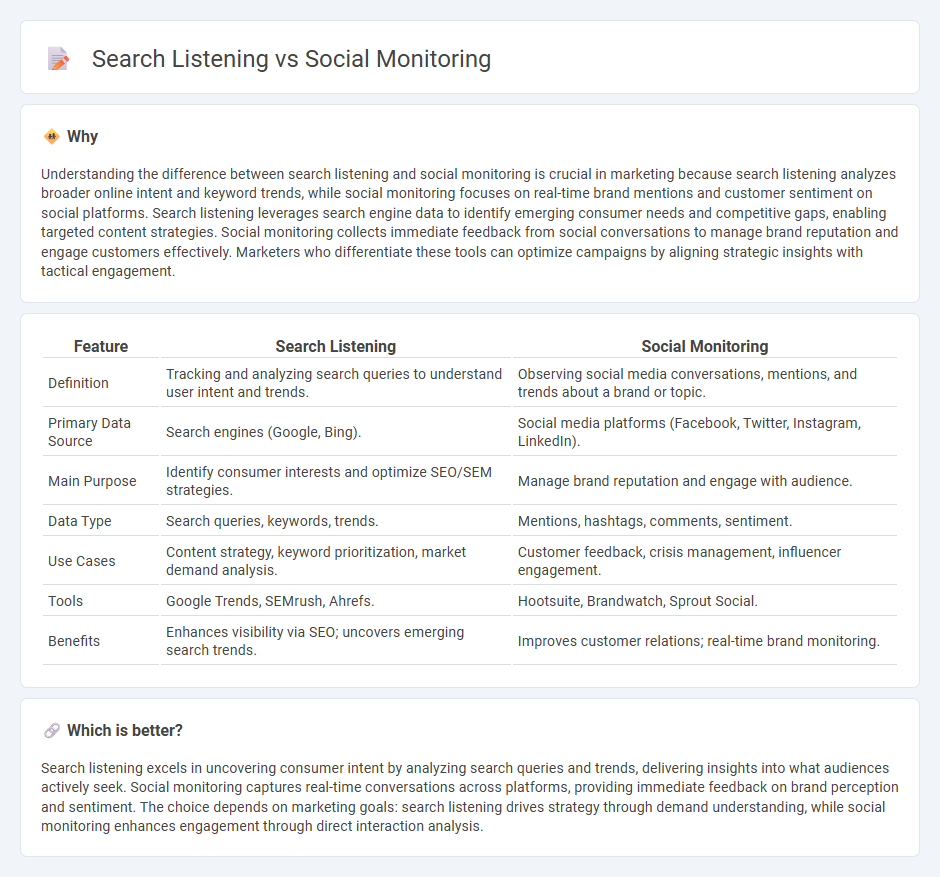
Search listening captures consumer intent by analyzing search queries and trends across search engines, providing insights into what audiences actively seek. Social monitoring tracks and analyzes brand mentions, sentiment, and conversations on social media platforms to gauge public perception and engagement. Explore how integrating these strategies can enhance your marketing intelligence and customer understanding.
Why it is important
Understanding the difference between search listening and social monitoring is crucial in marketing because search listening analyzes broader online intent and keyword trends, while social monitoring focuses on real-time brand mentions and customer sentiment on social platforms. Search listening leverages search engine data to identify emerging consumer needs and competitive gaps, enabling targeted content strategies. Social monitoring collects immediate feedback from social conversations to manage brand reputation and engage customers effectively. Marketers who differentiate these tools can optimize campaigns by aligning strategic insights with tactical engagement.
Comparison Table
| Feature | Search Listening | Social Monitoring |
|---|---|---|
| Definition | Tracking and analyzing search queries to understand user intent and trends. | Observing social media conversations, mentions, and trends about a brand or topic. |
| Primary Data Source | Search engines (Google, Bing). | Social media platforms (Facebook, Twitter, Instagram, LinkedIn). |
| Main Purpose | Identify consumer interests and optimize SEO/SEM strategies. | Manage brand reputation and engage with audience. |
| Data Type | Search queries, keywords, trends. | Mentions, hashtags, comments, sentiment. |
| Use Cases | Content strategy, keyword prioritization, market demand analysis. | Customer feedback, crisis management, influencer engagement. |
| Tools | Google Trends, SEMrush, Ahrefs. | Hootsuite, Brandwatch, Sprout Social. |
| Benefits | Enhances visibility via SEO; uncovers emerging search trends. | Improves customer relations; real-time brand monitoring. |
Which is better?
Search listening excels in uncovering consumer intent by analyzing search queries and trends, delivering insights into what audiences actively seek. Social monitoring captures real-time conversations across platforms, providing immediate feedback on brand perception and sentiment. The choice depends on marketing goals: search listening drives strategy through demand understanding, while social monitoring enhances engagement through direct interaction analysis.
Connection
Search listening and social monitoring are interconnected in marketing through their focus on real-time consumer insights and brand reputation management. Search listening analyzes search queries and keywords to identify trending topics and customer intent, while social monitoring tracks mentions, sentiments, and conversations across social media platforms. Combining these techniques enhances marketing strategies by providing a comprehensive view of audience behavior and emerging market opportunities.
Key Terms
Real-time Monitoring
Real-time social monitoring captures and analyzes live data from various social media platforms to detect immediate trends, sentiment shifts, and emerging issues, enhancing rapid response capabilities. Search listening, by contrast, gathers and interprets search engine queries and keywords over time to identify user intent and long-term behavior patterns. Discover the key differences and optimal strategies for leveraging real-time social monitoring effectively.
Sentiment Analysis
Sentiment analysis in social monitoring focuses on tracking brand mentions and customer feelings across social media platforms in real-time, providing insights into public perception and immediate reactions. In contrast, search listening leverages search query data to understand longer-term trends and consumer intent, capturing the emotional context behind information-seeking behavior. Explore more to discover how combining both approaches can enhance your sentiment analysis strategy.
Keyword Insights
Social monitoring centers on tracking brand mentions and customer feedback across platforms, providing real-time insights into public sentiment and engagement. Search listening emphasizes analyzing search queries and keyword trends to uncover consumer intent and market demand patterns. Explore how integrating both approaches can enhance your keyword strategy and deepen audience understanding.
Source and External Links
Social Media Monitoring: The Complete Guide for 2025 - Tracks, analyzes, and responds to brand, product, or industry conversations across social platforms in real time to manage reputation and identify trends.
Social Media Monitoring vs. Social Media Listening - Gathers and surfaces relevant social discussions about your brand, products, and competitors to promptly respond and inform business decisions.
Best Social Monitoring and Analytics Reviews 2025 - Collects, measures, analyzes, and interprets interactions from various online sources to understand brand sentiment and industry themes.
 dowidth.com
dowidth.com